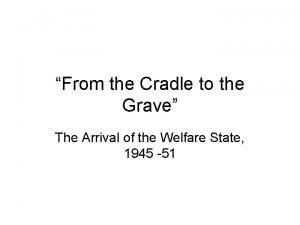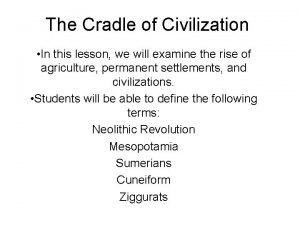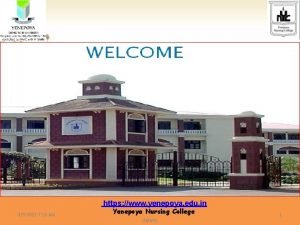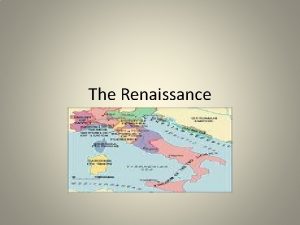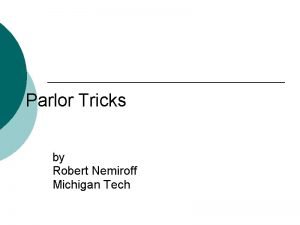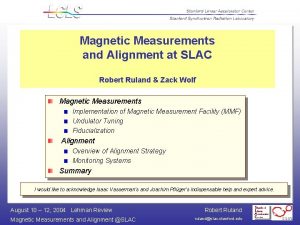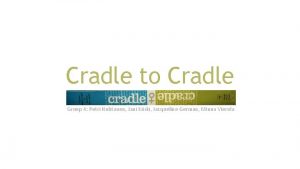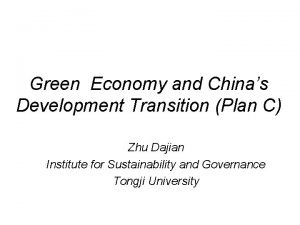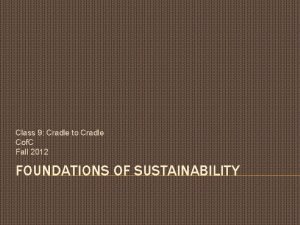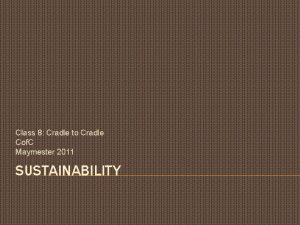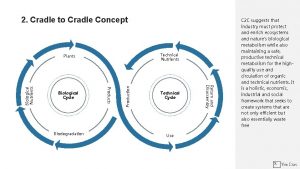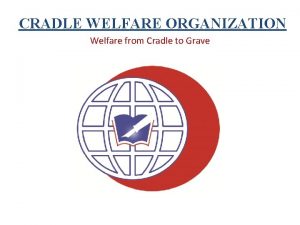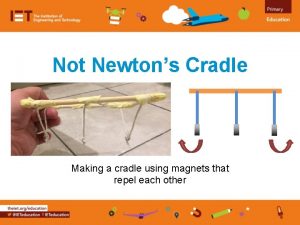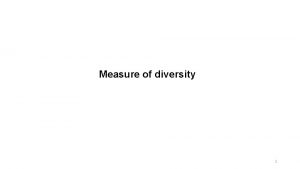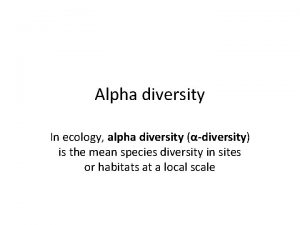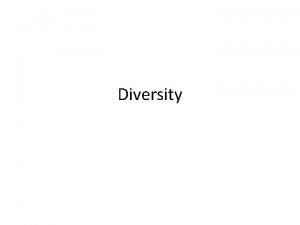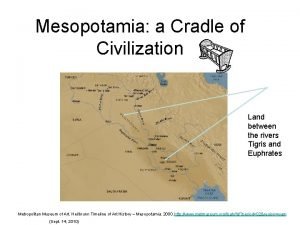Land of diversity and multiethnic state The Cradle





























- Slides: 29

Land of diversity and multi-ethnic state The Cradle of Mankind

Bridging the Gap between Academia and Industry to Build Competitiveness of Textile & Garment Industry: Overview of Ethiopian Scenario Areda Batu, Lecturer Deputy Chair of Garment and Fashion Design Co. C Institute of Technology for Textile, Garment & Fashion Design(i. OTEX) Bahir Dar University , Ethiopia

Structure of Presentation �Introduction �The Ethiopian Textile And Garment Industry � The Textile and Garment Academia in Ethiopia �Academia - Industry Partnership �i. OTEX Experience in Bridging the Gap & Build Competitiveness of Textile & Garment Industry �Challenges in Academia - Industry Partnership �The Way forward

INTRODUCTION n Socio-economic development has become increasingly knowledge-based. Hence increased role of Higher Education in society n Industry-university cooperation has emerged as major instrument for bridging the gap and building competitiveness both academia and industry. n The universities and the industries are dependent on each other as the university’s role is to produce human capitals to work at the industries, and the industries on the other hand need human capitals to run their business.

Multi faceted Role of Higher Education Lessons from International Studies

The Ethiopian Textile And Garment Industry �Ethiopia has had a long tradition of textile industry based on handloom production , which goes back at least 3, 500 years. �The introduction of Industrialized textile and clothing production is a recent phenomenon introduced only in 1939 during the brief Italian occupation from 1935 to 1940. �During the last 10 years, Ethiopia has experienced phenomenal expansion of textile and garment

The Ethiopian Textile And Garment Industry- Cont… �The Government of Ethiopia has identified textile and garment industry as a priority industry keeping in view its potential as engine that generates an employment opportunity, import substitution, export earning, and easy linkage in pursuing Agriculture Industrialization Development (ADLI) Strategy Led for

The Ethiopian Textile And Garment Industry- Cont… �The major challenges hampering the competitiveness of the Ethiopian textile and garment sector are: vlack of sufficient raw materials, v. Lack of Qualified Human Resources, vlow quality and productivity, vunsatisfactory product development capability, vlack of strategic company and production management philosophies v. Lack of Sustainability. How to preserve the capacity once built?

The Textile and Garment Academia in Ethiopia � Ethiopia has made a huge progress in higher education in the past decade, � with growth in the number of public universities leaping from just two in 1991 to 33 in 2011, � more than 50 Accredited Non-Government higher education institutions � 496 TVET institutions in the country in both the government and non -government ownership. � Among these only i. OTEX of Bahir Dar University is having � Textile Engineering � Garment Engineering and � Fashion Design

The Textile and Garment Academia in Ethiopia Bahir Dar University �Bahir Dar University is now among the largest universities in the Federal Democratic Republic of Ethiopia �with more than 35, 000 students � 57 undergraduate and � 39 graduate programs. �four colleges, �three faculties �one school, � three institutes (i. OT, i. OTEX and Land Administration)

The Textile and Garment Academia in Ethiopia i. OTEX - Bahir Dar University � Institute of Technology for Textile, Garment and Fashion Design (i. OTEX) of Bahir Dar University is the only higher education structured in the level of 'Institute of Technology' to educate specialized professionals for the filed of textile, garment and fashion design in the country � The Institute has a history of more than 40 years, currently , �more than 1, 300 students � 5 undergraduate Program � Fashion Design � Garment Engineering � Textile Engineering � TVET in Garment Engineering � 1 graduate programs. � Textile Technology � Ph. D by Research

Academia - Industry Partnership �A key element of the industrial development process and moves to strengthen competitiveness �Till recent years, regular University-Industry partnership, which is critical to raising funds from corporate sources as well as restructuring the curriculum with the changing needs of the industry, was missing in Ethiopia in this sector.

Academia - Industry Partnership � There is a growing realization amongst the government, academic institutions and the industry, of the urgent need to bridge these skill gaps in the textile and garment sector. � Overall the partnership is surprisingly weak � Those that exist usually involve low levels of performance. � Benefits to either side not clear � Weakly institutionalized: �Short duration �Individuals rather than country based �Mostly training/education; little services/consulting or research �Some positive cases, but little evidence of system-wide

Initiatives by i. OTEX to Bridge the Gap �working to strengthen Technical and Vocational Education and Training (TVET) by focusing on training qualified teachers. �Implemented Qualified Internship Semester in industry for all students

i. OTEX Experience in Bridging the Gap & Build Competitiveness of Textile & Garment Industry

Initiatives by i. OTEX to Bridge the Gap (1) �Involvement of industry professionals in restructuring the curriculum at i. OTEX. o All programs in the institute was developed based on industry needs. �Established Institute – Industry Linkage Office to �coordinate the work of student internship �establish a strong relationship between industries and the institute (i. OTEX) for their common benefits �identify core problems of textile and garment industries and research areas through interns and mobilize i. OTEX staff members to tackle the

Initiatives by i. OTEX to Bridge the Gap (2) �Establishment of Student Industrial Internship through Institute – Industry Linkage Office for one semester in all curriculum. �This helpes the student to �understand the reality of different kinds of work

Initiatives by i. OTEX to Bridge the Gap (3) �Establish Technology Transfer Office to �assessment and prioritization of current technological constraints, facilitation and catalysis of demand-driven applied research, and, initiating and promoting intra and request-powered training schemes for respective stakeholders in the sector. �following up of the implementation of the solutions/recommendations to be proposed by research team �assigning researchers, following up the documentation, fabrication, dissemination and impact assessment of provided technology

Initiatives by i. OTEX to Bridge the Gap (4) � Out put of Technology Transfer Office �Partnership with Bahir Dar and Kombolcha Textile Share Company �Partnership was initiated by Ethiopian Privatization and Public Enterprises Supervising Agency (PPESA). �Training was conducted in Bahir Dar and Kombolcha textile Share Company in 2011 �Estimated that the companies could save as much as ETB 10 million/year to ETB 30, 493, 769 /year only with simple changes. �The training for Bahir Dar and Kombolcha Textile Share Company continues in 2012 also.

Initiatives by i. OTEX to Bridge the Gap (5) �Establishment of Textile & Garment Research Centre(TGRC) � To enhance the competitive capabilities of small and medium-sized Textile and Garment manufacturers through applied research and by providing them with management training, product development support, and market identification and analysis services. �Formation of a National Knowledge Network to Connect Institutions o In the process of establishing a common database for information and knowledge sharing. o establishing of African Journal of Textile and Apparel �Involvement of Fashion Design Professional from Industry to Academia.

Initiatives by i. OTEX to Bridge the Gap (5) �Involvement of Alumni as mentor of Students during their industrial internship �Product Development and material testing service to Amhara Police Commission and Bahir Dar Textile Share Company. �Organizing Seminars, Conferences and Workshops. �Memorandum of Understanding Signed between i. OTEX and ETGAMA. �Different Technologies are also ready to be transferred to the Industry. �Modified hand loom �Extraction of Starch from Avocado and Mango wastes �….

Challenges in Academia - Industry Partnership Academi a �Full potential is far from being utilised due to the basic difference in understanding the benefit of partnership and perception of Self-sufficiency of both parties. �Academia is largely unaware of the real industrial and national needs and unable to market its strengths to industry adequately. �lack of appropriate incentive to faculty, absence of proper recognition for practising faculty. �Explosive student population increase

Challenges in Academia - Industry Partnership Industry �Insensitivity to, or lack of cognizance of, the tons of resource potential of the academia �much dependence on available foreign know-how and expensive, eminent professional consultants; �Industries prefer outsourcing research in their area to different consultant than collaborating with Academia �Absence of Clear funding mechanism

Challenges in Academia – Industry Partnership INDUSTRY Money Good Products Big Profit Margin Low Production Costs ACADEMIA /RESEARCHER Impact-Factor Papers Research Awards Career Promotion Produce Graduates CALIBRATE MINDSET One Goal One Aspiration Win-Win for All High Commercial Value Big Market NEW PRODUCTS Satisfy International Standards Low Production Cost Big Profit Margin

The Way Forward Academia Gov ernment Industry

Role of Government �Involving the academia in country’s Textile and Garment police issues �Provision of Incentives development for the academia-industry collaboration/partnerships. �Tax exemption for work done by

Role of Industry �Involving Academia for Joint Research and Project Interaction �Providing internships and engaging students in experiential learning and practical research projects.

Role of Academia �Involving Industries for Joint Research and Project Interaction �Developing and Implementing Refresher course �Establishing Center for Continuing Education Programmes �Build both technical and managerial capability of the industries by undertaking training and consultancy services.

Together we can make Africa the best sourcing destination of Textile and Apparel !!!
 Cradle to cradle design
Cradle to cradle design Cradle to grave cradle to gate
Cradle to grave cradle to gate Cradle to cradle boek
Cradle to cradle boek Cradle to grave housing report
Cradle to grave housing report Stateless-nation
Stateless-nation Multiethnic state definition
Multiethnic state definition Multiethnic state definition
Multiethnic state definition Multiethnic state definition
Multiethnic state definition Why is genetic diversity important
Why is genetic diversity important Ecosystem jigsaw activity
Ecosystem jigsaw activity What are landforms
What are landforms An area of land largely enclosed by higher land
An area of land largely enclosed by higher land The cradle of civilization
The cradle of civilization Golden cradle kindergarten
Golden cradle kindergarten Cradle pattern
Cradle pattern Foot board comfort device
Foot board comfort device Cat's cradle summary chapters
Cat's cradle summary chapters Cradle of liberty merit badge college
Cradle of liberty merit badge college Pivoted cradle balancing machine
Pivoted cradle balancing machine Newton's cradle
Newton's cradle Leg cradle to lateral lunge
Leg cradle to lateral lunge Cradle of the renaissance
Cradle of the renaissance Newton's cradle
Newton's cradle Newton's cradle
Newton's cradle What are the earliest childhood memories of jose rizal
What are the earliest childhood memories of jose rizal Craddle alignment technique
Craddle alignment technique Sven jani
Sven jani Pizzle eye
Pizzle eye Mesopotamia the cradle of civilization worksheet answers
Mesopotamia the cradle of civilization worksheet answers Cradle to grave
Cradle to grave



